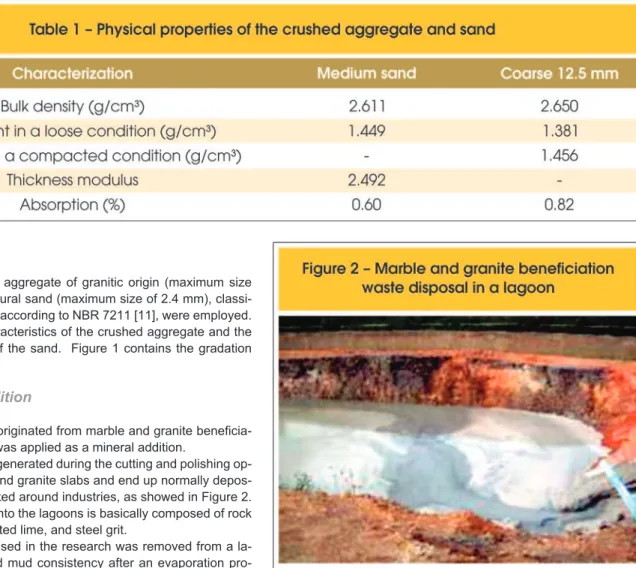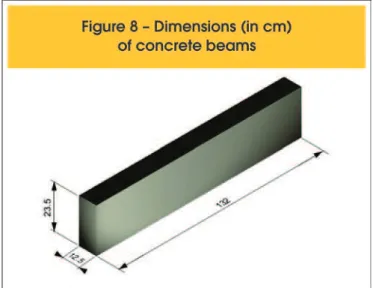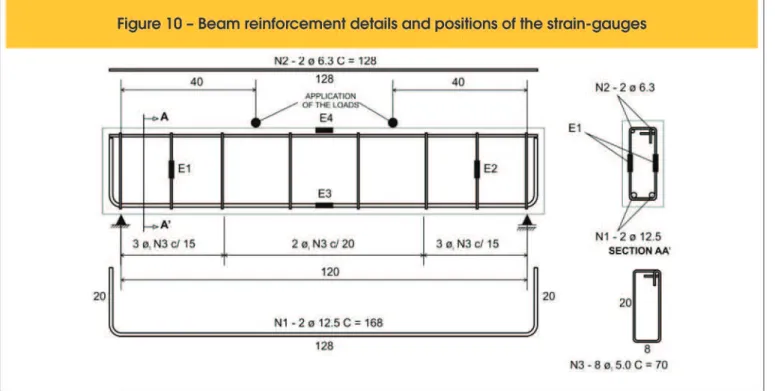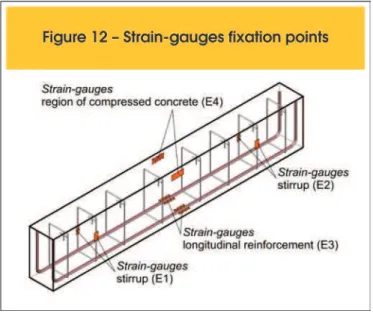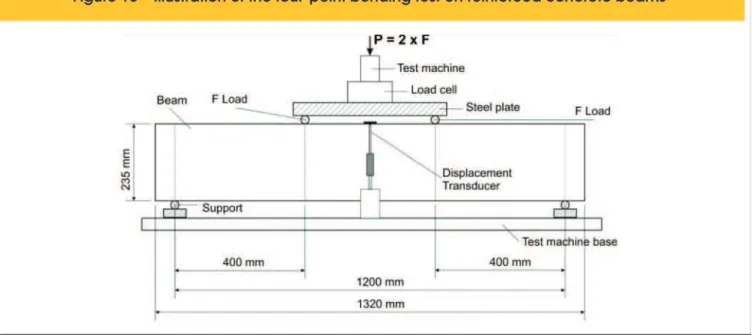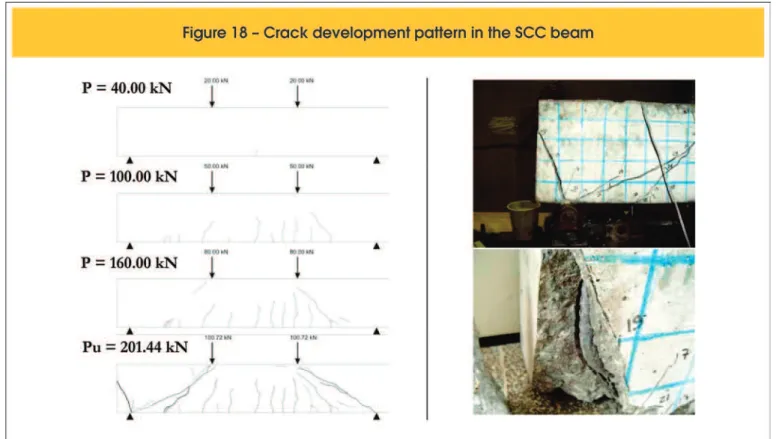This study was carried out to investigate the behavior of self-compacting concrete beams reinforced with steel ibers subjected to the bending. For such, steel ibers with a ratio l/d of 50, in a volume fraction of 1% were used. Reinforced concrete beams with dimensions of 12,5 x 23,5 x 132 cm were in four-point bending, at 28 days of age. During the test were taken strain measurements in the stirrups and the longitudinal reinforce -ment bars, besides measure-ments of the strain in the compressed region of concrete and of delections at mid-span. The data collected showed that the addition of steel ibers in self-compacting concrete (SCC) promotes a notable increase in the beam’s resistant capacity, resulting in lower delections at mid-span, lower deformations of the reinforcement bars, both transversal as longitudinal, and improved cracking control, compared to control beams produced with conventional concrete, with or without steel ibers.
Keywords: Self-compacting concrete; Steel ibers; Reinforced concrete beams; Four-point bending test.
Este estudo foi desenvolvido para avaliar o comportamento de vigas de concreto autoadensável (CAA) reforçado com ibras de aço submetidas à lexão. Para tal, foram utilizadas ibras de aço com fator l/d = 50, em uma fração volumétrica de 1%. Foram confeccionadas vigas armadas de dimensões (12,5 x 23,5 x 132) cm, as quais foram ensaiadas por lexão a quatro pontos, aos 28 dias de idade, sendo feitas medições das deformações apresentadas nos estribos e armadura longitudinal, além de medições das deformações do concreto na região comprimida e das lechas no meio do vão. Os resultados dos ensaios mostraram que a adição das ibras de aço ao CAA promoveu sensível ganho na capacidade resistente da viga, com menores lechas, menores deformações das armaduras, longitudinal e transversal, e melhorado controle da issuração, em comparação às demais vigas produzidas com concretos convencionais, com e sem ibras de aço.
Palavras-chave: Concreto autoadensável; Fibras de aço; Vigas de concreto armado; Ensaio de lexão a quatro pontos.
Steel ibers reinforced self-compacting
concrete – behavior to bending
Concreto autoadensável reforçado com ibras
de aço – comportamento à lexão
A. R. BARROS a
arb@ctec.ufal.br
P. C. C. GOMES b
pgomes@ctec.ufal.br
A. S. R. BARBOZA c
alramos@ctec.ufal.br
a Universidade Federal de Alagoas, Superintendência de Infraestrutura, arb@ctec.ufal.br, Av. Lourival Melo Mota, s/n, Tabuleiro do Martins.
CEP: 57072-970, Maceió, Brasil.
b Universidade Federal de Alagoas, Unidade Acadêmica Centro de Tecnologia, pgomes@ctec.ufal.br, Av. Lourival Melo Mota, s/n, Tabuleiro do Martins.
CEP: 57072-970, Maceió, Brasil.
c Universidade Federal de Alagoas, Unidade Acadêmica Centro de Tecnologia, alramos@ctec.ufal.br, Av. Lourival Melo Mota, s/n, Tabuleiro do Martins.
CEP: 57072-970, Maceió, Brasil.
Abstract
Steel ibers reinforced self-compacting concrete – behavior to bending
1. Introduction
Self-compacting concrete (SCC) is characterized by high luidity and moderate viscosity. It is able to move in the formworks and ill them uniformly under its own weight. Moreover, the use of SCC is cost-effective because this concrete does not give rise to any mechanical vibrations, it requires fewer construction workers during the casting stage, and the noise level due to mechanical vibration equipment is lower at the construction site, thereby diminishing sound effects on the environment and improving working conditions. The SCC has been widely employed to produce beams of complex shapes and/or with high density of reinforcement structures.
Besides ensuring the expulsion of air bubbles from the fresh mix with no need for mechanical vibration, the SCC must have segre -gation ability and bleeding strength. In concrete mixes such char-acteristics are obtained by addition of third generation superplas-ticizers and a high volume of ine materials, and/or by introduction of viscosity modifying agents (Gomes [1]).
From a mechanical viewpoint, both the conventional and self-compacting concretes perform less satisfactorily when they are subjected to tensile effects. This has motivated constant research into new materials that can meet the demands of structural per-formance. In order to achieve the best possible material; that is, a concrete with fewer constitutive deiciencies and/or a larger num -ber of positive features, several researchers have been devoted to the optimization of the properties of concrete beams, and new components and admixtures have been investigated.
One way to improve the physical and mechanical properties of a concrete is the production of a composite material either via addi-tion of steel bars commonly used as reinforcement in current civil engineering practices or by random introduction of steel ibers into the concrete mixture. A combination of both approaches is also possible, although the latter has found more restricted and less widespread use.
As outlined by Kim and Mai [2], both the cement matrix and the ibers keep their original chemical and physical identities in the composite material. However, due to the presence of an interface between these two constituents, a combination of mechanical properties that cannot be obtained with the constituents alone is achieved in the hybrid concrete.
Bearing in mind the technical and economic beneits of SCC, the addition of steel ibers to this type of concrete should signiicantly enhance its properties in the hardened state, mainly when it is sub-mitted to tensile stress, as in the case of concrete beams under lexural effects. Therefore, if the use of SCC is advantageous, the addition of steel ibers should provide it with new positive features and further possibilities of application, since a more eficient mate
-sile strength. As cited by Borges [3], the ten-sile strength of concrete has a direct inluence on the development of cracks. Furthermore, according to CEB-FIP [4], the tensile strength is also related to the contribution of the material to shear efforts, among other aspects. The addition of steel ibers to concrete gives rise to two important ef -fects. First of all, it contributes to reinforcement of the composite under loads that induce tensile stress. Secondly, the presence of the iber improves the ductility and toughness of the material (Gava et al. [5]). Concerning SCC, its well-known advantages are related to the lower electrical energy necessary during placement and compacting of this type of concrete. However, the large amount of iner particles present in this material generally culminates in a denser structure whose characteristics and mechanical behavior can be enhanced. Nevertheless, these factors are often overlooked because the main action of SCC in its fresh state is illing all the empty voids in the formworks with no vibration efforts. If the denser structure of SCC diminishes the presence of air voids so that better bonding between the concrete and steel is achieved, (Almeida Filho [6]; Hossain and Lachemi [7]), this could be beneicial and lead to better results in terms of the mechanical behavior of the constituents compared with that of conventional concrete. In addition, if steel ibers are intro -duced into SCC with a view to arresting the propagation of cracks and improving the tensile strength, the resulting material may have a longer lifetime and/or present better behavior compared with struc-tural elements made with ordinary cement concrete.
2. Materials
Four different concrete mixes were designed in this study, in order to enable future comparisons among them. The Portland cement and the water-to-cement ratio were kept constant. The concrete mixes studied herein were designated self-compacting concrete (SCC); steel iber-reinforced self-compacting concrete (SFRSCC); reference concrete (RC); and steel iber-reinforced reference con-crete (SFRRC).
sure to the sun and later stored in barrels. Thereafter, the larger particles that remained from the drying process were broken, as shown in Figure 3, and sieved on a # 0.3mm mesh. Finally, the powdery material was stored in sealed containers for later use as mineral addition.
The MGBW is considered to be predominantly a non-active ad-dition, thus contributing to higher compactness of the internal structure of the cementitious material mainly through physical action, also known as iller effect. Figure 4 illustrates the grada -tion of the MGBW.
2.4 Admixtures
A superplasticizer (SPC) was used in the self-compacting concrete mix, and a plasticizer (PC) was employed in the reference concrete mix, to promote adequate workability.
Plasticizers are normally employed to reduce water contents between 5% and 10%, reaching 15% in high workability concretes, according to Neville [12]. As explained by Mehta and Monteiro [13], plasticizer use leads to higher luidity without increasing water content.
Tensoactive agents are the main active components of these ad-mixtures, which in the case of plasticizers will be concentrate at the interface between two phases immiscible, modifying the
physical-2.2 Aggregates
A crushed limestone aggregate of granitic origin (maximum size of 12.5 mm ) and natural sand (maximum size of 2.4 mm), classi -ied as medium sand according to NBR 7211 [11], were employed. Table 1 lists the characteristics of the crushed aggregate and the physical properties of the sand. Figure 1 contains the gradation curves.
2.3 Mineral Addition
A limestone powder originated from marble and granite beneicia -tion waste (MGBW) was applied as a mineral addi-tion.
This kind of waste is generated during the cutting and polishing op -erations of marbles and granite slabs and end up normally depos-ited in “lagoons” located around industries, as showed in Figure 2. The waste released into the lagoons is basically composed of rock powder, water, hydrated lime, and steel grit.
expo-Steel ibers reinforced self-compacting concrete – behavior to bending
chemical forces that act in this interface. These substances are adsorbed by cement particles giving a negative electrical charge which results in repulsion between the particles. Thus, the particles gains higher mobility and the water molecules are not trapped and are therefore able to lubricate the mix and increase the workability (Neville [12]).
The superplasticizers are a special category of water reducing agents which are formulated from components that allow water content reduction between 25% and 35% (Neville [12]), resulting in extreme workability to the concretes where they are incorpo-rated. The tensoactive agents of the superplasticizer involves the cement particles, charging them negatively, causing electrostatic repulsion of them, which results in cement particle dispersion caus-ing a reduction in viscosity (Dal Molin [14]). Superplasticizer usage in SCC is practically inevitable. Its use is responsible for one of the main properties of this concrete, the luidity. Without superplasti-cizer it would impossible to get self-compacting concrete.
2.5 Water
The water used for concrete production in this study was obtained from of the supply system of the Federal University of Alagoas.
2.6 Fibers
Steel bars with tensile strength of 500 MPa and diameters of 6.3 mm, 5.0 mm, and 12.5 mm were used as reinforcement in the beams. The density of the steel was 7850 kg/m³.
Commercially available hooked-end straight steel ibers measuring 30 mm in length and 0.6 mm in diameter, as depicted in Figure 5, with tensile stress around 1100 MPa, were employed.
According to NBR 15530 [15], the steel iber used in this study cor -responds to the A-I type.
3. Experimental Program
3.1 Concretes mixtures
Firstly, the sand and crushed aggregate were placed in the mixer, which was allowed to work for about 30 (thirty) seconds, for in -corporation of adsorbed water. Next, the mixer was interrupted, cement and MGBW were introduced into it, and the mixture was further mixed for about 30 seconds. Part of the mixing water (80% of water-to-cement ratio) was then added to the equipment, and the mixing was allowed to proceed for about 90 seconds. The mixing process continued for about 120 seconds after addition of the admixture (superplasticizer in the case of SCC and plas-ticizer for RF) and the remaining mixing water (20% of water/ cement ratio),. When the mix process was complete, steel ibers were added and mixed for another 60 seconds in the cases of SFRSCC and SFRRC only.
Table 2 summarizes the main differences in terms of the dosages employed in this research.
recommendations of Tviksta [16], according to whom the dosage of steel ibers per volume in a steel iber-reinforced self-compact -ing concrete (SFRSCC) can be obtained from an exist-ing SCC with a slump value between 650 mm and 700 mm.
The need for changes in the SCC dosage when steel ibers are added to the mixture can be assessed by the iber factor (Fsf),
ac-cording to Eq. (1):
where mf is the mass of added iber (kg/m³); lf is the length of the iber; and df is the diameter of the iber.
On the basis of the recommendations of Tviksta [16] and prelimi-nary tests, it is possible to add steel ibers up to a 1% volume ratio (78.5 kg/m³), with no alterations in the properties of fresh SCC. Table 3 displays the concretes mixes prepared for this study.
3.2 Fresh concrete experiments
The illing ability of the self-compacting concrete with and without steel ibers was evaluated by means of the slump low test.
Atten-tion was focused on measurement of the slump low (Df), which is
the mean value of two perpendicular diameters measurements (d1 and d2) obtained after release of a standard slump cone in the con-crete. The time, in seconds, necessary for a mean diameter gain of 500 mm to be achieved is designated T50. This is the most com
-monly employed test both in the laboratory and in the construc-tion site, due to its easiness and quickness. Addiconstruc-tionally, it uses the same equipment that is often used for conventional concretes. Moreover, the slump low test enables controlling the segregation tendency of the coarse aggregate. Figure 6 brings both an illustra-tion and pictures regarding execuillustra-tion of the test.
The type B measurer recipient used was illed with concrete and placed as in the case of the molding of the specimens. Thus, when the self-compacting concrete was evaluated, the illing of the re-cipient was accomplished by only placing the concrete at once, without any kind of vibration. As for reference concretes, with and without ibers, the recipient was illed in two layers, being each of them compacted by immersing a rod vibrator.
3.3 Molding the specimens
For each concrete produced herein, one reinforced concrete beam with 12.5 cm width, 23.5 cm height, and 132 cm length was cast , as displayed in Figure 8.
The molding of beams varied, depending on the compacting pro-cess undergone by each type of concrete employed in this work. In the case of the SCC and SFRSCC , as the name suggests, there was no need for vibration of any kind for it to be compacted in the
formworks (Figure 9a). On the other hand, RC and SFRRC were compacted by mechanical vibration in a vibrating table (Figure 9b).
3.4 Curing of the specimens
After demolding, which was carried out after 48 hours of comple-tion of the molding process, the beams were subjected to wet cur -ing, for which the beam was placed on a sand bed and covered with cotton waste. The wetting of the beams was conducted once or twice a day, depending on the environment temperature. Such curing was repeatedly accomplished until the test age of 28 days. Some beams were demolded at 24 hours after completion of the molding process. Then, the cylindrical specimens, employed in the compression and modulus of elasticity tests, and the prismatic specimens, used in the bending test, were cured by immersion in water, where they remained until the test age of 28 days.
3.5 Four-point bending test of reinforced
concrete beams
Steel ibers reinforced self-compacting concrete – behavior to bending
in the longitudinal reinforcement and in the region of compressed concrete. The ixation of strain-gauges in the reinforcements was performed 24 hours before casting of the beam.
The ixation of the strain-gauges in the region of compressed con -crete, the ixation of a lat steel bar on the top of the beam for mea-surement of displacements, and the demarcation of a rectangular mesh, measuring 4.7 cm by 5 cm, along the beam web height for mapping of the cracks were done 24 hours before the tests were performed, as shown in Figure 11. The assessment of the evolu-tion of cracks in the beams as a funcevolu-tion of the load increase was carried out using force load increments of 1 ton.
A pair of strain-gauges were positioned in each point of interest for measurement of deformations (E1, E2, E3, and E4), according to Figure 12.
4. Results and discussions
4.1 Assessment of the concretes in the fresh state
Observation of Table 4, reveals that the addition of steel ibers at a 1% volume fraction did not result in signiicant slump reduction in the case of the reference concrete (RC). As for SCC, the ad-dition of steel ibers caused 10.6% decrease in the luidity of this cement, as veriied from the Df values presented in Table 4. Steel
incorporation into SCC also promoted greater concrete cohesion, as observed from the increase in T50.
Despite the reduced low spread and larger T50 compared with SCC, the SFRSCC attended to the self-compacting characteristics in the slump-low test, since in the technical literature it is recom-mended that Df should lie between 600 and 750 mm, and that T50
should be in the range of 3 to 7 seconds.
In general, the reference concretes RC and SFRRC presented higher levels of air voids compared with the values found for the self-compacting concretes SCC and SFRSCC. This is probably due to the use of a plasticizer in the former cases, which could have led to the appearance of air bubbles during mixing of the fresh concretes RC and SFRRC. Moreover, the greater volume of ine particles present in the SCC composition may have generated lower amounts of air voids, compared with those obtained in the case of the reference concretes.
4.2 Mechanical properties of the studied concretes
Table 5 summarizes the mechanical properties of the studied con -cretes, at 28 days of age. Compression (fc) and elasticity modulus
(Ec) tests (NBR 8522 [20]) were conducted on cylindrical speci
-mens with 10-cm diameter and 20-cm height. The concretes bend-ing strength (fctM) was also determined in accordance with NBR
12142 [21], by using prismatic specimens with 15-cm width, 15-cm height, and 50-cm length. Four cylindrical specimens were molded for each produced concrete for the compression test, 04 cylindrical specimens were produced for evaluation of the elasticity modulus, and 03 prismatic specimens were made for the bending test. Despite the decrease in the elasticity modulus after addition of the steel iber, the SCC presented a 10.3% rise in its compression av-erage strength and 141.6% elevation in the bending resistance in the case of prismatic specimens (Table 5). In contrast with some literature reports on iber-reinforced material, the increased SCC compression strength observed after addition of steel ibers has also been veriied in other works (Marangon [22]). Therefore, this point must be further investigated in future studies.
Steel ibers reinforced self-compacting concrete – behavior to bending
distance between supports and applied loads, as well as the posi-tion of the employed instrumentaposi-tion.
Figure 14 displays the results from the deformation measurements performed in the region of compressed concrete.
According to Figure 14, for the same level of loading the addition of steel ibers yielded smaller deformations in the region of beam compression in the case of SFRSCC, compared with the SCC beam. But the effect of the ibers was lower in the inal stage of beam load capacity, where there was superposition of the curves corresponding to SCC and SFRSCC.
With regard to RC, the introduction of steel ibers considerably im -proved the behavior of the concrete in the region of beam
com-pression, as veriied by comparison with the curve relative to SFR -RC. In the inal stage of load capacity, the SFRRC beam exhibited better behavior.
As for the iber-reinforced concretes SFRSCC and SFRRC, the slowing down of the development of cracks due to the presence of the steel ibers may have placed the neutral line of the upper border of the beam cross-section further away, compared with concretes without added ibers, SCC and RC. This might have led to an enlargement of the beam compression zone, consequently favoring the appearance of fewer deformations in the compressed concretes. This can be clearly observed in Figure 14, by compar -ing RC with SFRRC and SCC with SFRSCC.
longitudinal reinforcement were released, and some channels of the data acquisition system did not work correctly, which did not allow for the measurement of deformations in the longitudinal bars of the SCC beam.
As shown in Figure 15, the addition of steel ibers provided the RC with greater tensile load-capacity, which is developed during the bending of the beam . This culminates in smaller deformations of the longitudinal reinforcement of the SFRRC beam, compared with the RC beam, showing that part of the tensile stress was resisted by the steel-iber reinforced concrete, thereby relieving the action of the longitudinal reinforcement.
The behaviors of SFRRC and SFRSCC were similar, at least up to a load of approximately 100 kN. This is because the SFRSCC beam displayed slightly better performance with increasing load, compared with the SFRRC beam. This enabled the achievement of greater loading levels with smaller deformations in the longitu-dinal reinforcement It is noteworthy that the strain-gauges ixed in the longitudinal reinforcement of the SFRSCC beam were re -leased when the load was 186.2 kN, corresponding to 6.75‰ de-formation. Thus, the curve depicted in Figure 15 does not describe the complete behavior relative to the deformation of the SFRSCC beam longitudinal reinforcement.
The curves represented in Figure 16, indicate smaller stirrups deformations in the self-compacting concrete beams SCC and SFRSCC, as observed from the load levels reached by the con-cretes. However, the addition of steel ibers to SCC did not imply an evident beneit in terms of counteracting the action of shear
stress acting on the beam. Perhaps, this result is due to the favor -able behavior of the matrix, which generates a better concrete-steel bond (Almeida Filho [6]). Therefore, there was no signiicant gain in shear strength after addition of the ibers.
On the other hand, the shear stress was considerably counteracted when steel ibers were incorporated into the RC. This is an indication that the steel ibers act on the region of shear resistance, with direct action on inclined cracks (in a similar way to stirrups) that appear in the beam regions located between the load and the support. The measurements of the mid-span delections of the beams are presented in Figure 17. In the aforementioned igure, the load ver -sus delection curves evidence (see the legend of the curves) the load at which the irst crack occurred in each of the beams. According to the curves in Figure 17, taking into account the same loading level, SFRSCC was the material that underwent the small -est delections. Probably, the better concrete-steel bond obtained in this case by using steel ibers as well as the denser internal structure of SCC, achieved through use of a high volume of ine particles in the mix, provided a greater beam deformation capacity. Similarly to SCC, the RC also presented larger load capacity after incorporation of steel ibers. As observed previously, results from the longitudinal reinforcement deformation studies demonstrated that the addition of steel ibers to RC reduced the demand for lon -gitudinal reinforcement, indicating that SFRRC was able to coun-teract part of the tensile stress developed in the bending. Indeed, the data from Figure 17 relect this behavior, evidencing greater SFRRC beam ductility compared with the RC beam.
In relation to the appearance of the irst crack, there was a 100% increase in the load at which the irst crack was detected in the SFRSCC, compared with the SCC beam. On the other hand, the incorporation of steel ibers into the RC provided a 200% rise in the load that caused the irst crack.
The development of cracks in the beams is illustrated in Figures 18 to 21 for each of the concretes, from the irst crack until failure. The loads that generated the cracking stages are also presented. The development of cracks in the SCC beam can be observed in Figure 18.
Steel ibers reinforced self-compacting concrete – behavior to bending
Figure 19 reveals that the incorporation of steel ibers into the SCC avoid -ed slipping of the longitudinal reinforcement in the beam support region, in contrast with what occurred in the case of the SCC beam (Figure 18).
Finally, the mapping of cracks in the SFRRC beam is displayed in Figure 21.
5. Conclusions
The conclusions presented in this study were obtained from initial investigations on steel iber-reinforced self-compacting concrete, and therefore indicate a trend of the possible behavior of this con-crete after addition of steel ibers to its mixing, both in the fresh and hardened states.
Complementary studies are underway, in order to examine the ef-fect of volume fractions, types and characteristics of the ibers, and self-compacting concrete dosages on the behavior of composite concretes. Additionally, research targeting the SCC-steel iber bond using tests and a number of samples that is suficient for the statistical analysis of the obtained results is being conducted. Thank to improved control of cracks, the SFRSCC beam contain-ing 1% steel iber in its volume fraction exhibited better structural behavior, affording a greater load-capacity with smaller deforma-tions in the stirrups, longitudinal reinforcement, and region of com-pressed concrete in the upper border of the beam cross-section. However, despite the better behavior of the SFRSCC, the steel ibers were more beneicial in the case of the SFRRC beam, where the amount of deformations in the reinforcement and compressed regions was more signiicantly reduced compared with the corre-sponding concrete without added steel (RC beam).
The steel ibers in SFRSCC did not give rise to evident beneits regarding the reinforcement of the SCC beam. Indeed, the advan -tages of introducing steel ibers into SCC included only the slow-ing down of the appearance of the irst crack and the presence of smaller delections, compared with the SCC beam. The stronger
concrete-steel bond due to the denser internal structure of SCC was able to promote enhanced beam behavior, compared with RC and SFRRC. In other words, the addition of steel ibers to SCC at 1% volume fraction did not signiicantly reinforce the SCC con -crete. In fact, this behavior had not been expected for the SFRSCC beam considering the results from the bending tests performed on prismatic specimens. However, it was veriied that at least two beams should have been produced for each analyzed concrete type, in order to aid observations of variations in concrete behav-ior. This in turn should allow for better analysis of each of the dos -ages. The use of different volume fractions of steel ibers should also be interesting, so that changes in the behavior of the beams due to the addition of different increments of iber could be veriied.
6. Acknowledgements
The authors gratefully acknowledge FAPEAL, CNPq, CAPES, LEMA of the Technological Researches Nucleus (NPT) of the Fed -eral University of Alagoas (UFAL), the beneiciation companies of marble and granite of Alagoas, the cement factories ZEBU and POTY, the factory of chemical admixtures MBT – Master Builders Technologies, and the companies BRITEX and IMCREL.
7. References
[01] GOMES, P. C. C. Optimization and characterization of high-strength self-compacting concrete, Barcelona, 2002, Tese (doutorado) – Curso de Pós-Graduação
em Engenharia Civil, Universitat Politècnica de Catalunya, 150 p.
Steel ibers reinforced self-compacting concrete – behavior to bending
iber reinforced composites. Elsevier Science Ltd. 1st Ed. Oxford, U.K, 1998. ISBN 0-08-042695-6.
[03] BORGES, J. U. A. Análise do comportamento de vigas de concreto de alto desempenho por meio da mecânica da fratura, São Paulo, 2002, Tese (doutorado) – Escola Politécnica, Universidade de São Paulo, 311 p.
[04] COMITÉ EURO-INTERNATIONAL DU BÉTON. CEB-FIP Model Code 1990. London, Thomas Telford, 1993.
[05] GAVA, G. P.; PIERI, T. S.; PRUDÊNCIO JR., L. R. Ensaio de lexão de vigas de concreto reforçado com ibras de aço: inluência da presença e posicionamento do entalhe e do número de ibras na seção issurada. e-Mat - Revista de Ciência e Tecnologia de Materiais de Construção Civil. v.1, n.2, 2004; p.114-127.
[06] ALMEIDA FILHO, F. M. Contribuição ao estudo da aderência entre barras de aço e concretos autoadensáveis, São Carlos, 2006, Tese (doutorado)
Civil, Universidade Federal de Alagoas, 115 p. [09] CAVALCANTI, D. J. H. Contribuições ao estudo
de propriedades do concreto autoadensável visando sua aplicação em elementos estruturais, Maceió, 2006, Dissertação (mestrado) – Programa de Pós-Graduação em Engenharia Civil, Universidade Federal de Alagoas, 141 p.
[10] ASSOCIAÇÃO BRASILEIRA DE NORMAS TÉCNICAS. Cimento Portland Composto. - NBR 11578, Rio de Janeiro, 1991. [11] ASSOCIAÇÃO BRASILEIRA DE NORMAS
TÉCNICAS. Agregados para concreto. - NBR 7211, Rio de Janeiro, 2005.
[12] NEVILLE, A. M. Propriedades do concreto. 2. ed. São Paulo: Pini, 1997. 828 p.
[13] MEHTA, P. K.; MONTEIRO, P. J. M. Concreto: estrutura, propriedades e materiais. São Paulo: PINI, 1994. 573 p.
JSCE-F503 – Method of Test for the Slump Flow of Concrete. 1990.
[18] OUCHI, M. Self-compacting concrete – development, applications and investigations. In: 17th Nordic
Concrete Research Symposium. Reykjavik, Iceland. 1999.
[19] ASSOCIAÇÃO BRASILEIRA DE NORMAS TÉCNICAS. Concreto. Determinação do teor de ar em concreto fresco – Método pressométrico. - NBR NM 47, Rio de Janeiro, 2002.
[20] ASSOCIAÇÃO BRASILEIRA DE NORMAS TÉCNICAS. Concreto. Determinação do módulo estático de elasticidade à compressão.
- NBR 8522, Rio de Janeiro, 2008. [21] ASSOCIAÇÃO BRASILEIRA DE NORMAS
TÉCNICAS. Determinação da resistência à tração na lexão em corpos-de-prova prismáticos. - NBR 12142, Rio de Janeiro, 1991.
